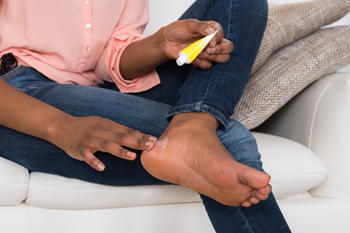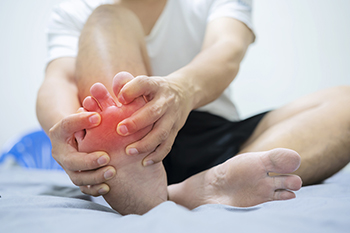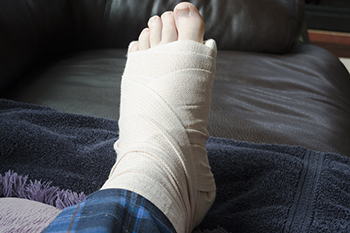Connect With Us
Blog
Items filtered by date: July 2022
What Causes Cracked Heels

For any person who cares about the health and appearance of their feet, cracked heels can pose a unique problem. This unattractive and potentially uncomfortable condition occurs when the skin surrounding the heels becomes thick and dry, producing a cracked texture. It is very important to familiarize yourself with the causes of cracked heels as this can reduce your chance of developing the condition. The principal cause of this ailment is lacking sufficient moisture in the skin of the heels. For example, if someone fails to properly moisturize and protect the elasticity of the skin in their heels, they are increasing their chances of developing cracked heels. Additionally, prolonged exposure to water can also cause cracked heels in some cases. This is because water can diminish important oils in the heels that keep the skin elastic. Therefore, if you are someone who spends a significant amount of time in damp or moist environments, you may be putting yourself at a greater risk of developing cracked heels. These are just some of the many causes of cracked heels. To learn more, contact a podiatrist who can help with your cracked heels.
Cracked heels are unsightly and can cause further damage to your shoes and feet. If you have any concerns, contact Jeffrey L. Bober, DPM from Maryland. Our doctor can provide the care you need to keep you pain-free and on your feet.
Cracked Heels
Cracked heels appear unappealing and can make it harder for you walk around in sandals. Aside from looking unpleasant, cracked heels can also tear stockings, socks, and wear out your shoes. There are several methods to help restore a cracked heel and prevent further damage.
How Do You Get Them?
Dry skin is the number one culprit in creating cracked heels. Many athletes, walkers, joggers, and even swimmers suffer from cracked heels. Age and skin oil production play a role to getting cracked heels as well.
Promote Healing
Over the counter medicines can help, especially for those that need instant relief or who suffer from chronic dry feet.
Wear Socks – Wearing socks with medicated creams helps lock in moisture.
Moisturizers – Applying both day and night will help alleviate dryness which causes cracking.
Pumice Stones – These exfoliate and remove dead skin, which allows for smoother moisturizer application and better absorption into the skin.
Change in Diet
Eating healthy with a well-balanced diet will give the skin a fresh and radiant look. Your body responds to the kinds of food you ingest. Omega-3 fatty acids and zinc supplements can also revitalize skin tissue.
Most importantly, seek professional help if unsure how to proceed in treating cracked heels. A podiatrist will help you with any questions or information needed.
If you have any questions, please feel free to contact our office located in Glen Burnie, MD . We offer the newest diagnostic and treatment technologies for all your foot care needs.
Simple Fall Prevention Methods

Research has indicated that approximately one in three adults fall at least once per year. This can lead to serious foot injuries that can hinder completing daily activities. There are simple methods that can be implemented that may help to reduce falling episodes. When the lighting is improved in the household, it will become easier to see steps and obstacles that may be easy to trip over. Additionally, removing frayed rugs can reduce the number of falls incurred, and it is important to hold on to handrails while going up and down the steps. Many patients find it helpful to install grab bars in the shower and toilet area, and using a non-skid bathmat can provide stability in the shower. When a walker or cane is used, the sense of balance is often increased, and it is beneficial to keep a phone within reach in case a mishap occurs. It is helpful to have routine physical and eye exams performed, and this is needed to monitor existing medication and eyeglasses. If you would like more information about how falling can affect the feet, and effective fall prevention methods, please consult with a podiatrist.
Preventing falls among the elderly is very important. If you are older and have fallen or fear that you are prone to falling, consult with Jeffrey L. Bober, DPM from Maryland. Our doctor will assess your condition and provide you with quality advice and care.
Every 11 seconds, an elderly American is being treated in an emergency room for a fall related injury. Falls are the leading cause of head and hip injuries for those 65 and older. Due to decreases in strength, balance, senses, and lack of awareness, elderly persons are very susceptible to falling. Thankfully, there are a number of things older persons can do to prevent falls.
How to Prevent Falls
Some effective methods that older persons can do to prevent falls include:
- Enrolling in strength and balance exercise program to increase balance and strength
- Periodically having your sight and hearing checked
- Discuss any medications you have with a doctor to see if it increases the risk of falling
- Clearing the house of falling hazards and installing devices like grab bars and railings
- Utilizing a walker or cane
- Wearing shoes that provide good support and cushioning
- Talking to family members about falling and increasing awareness
Falling can be a traumatic and embarrassing experience for elderly persons; this can make them less willing to leave the house, and less willing to talk to someone about their fears of falling. Doing such things, however, will increase the likelihood of tripping or losing one’s balance. Knowing the causes of falling and how to prevent them is the best way to mitigate the risk of serious injury.
If you have any questions, please feel free to contact our office located in Glen Burnie, MD . We offer the newest diagnostic and treatment technologies for all your foot care needs.
When to See a Podiatrist About Gout

Over the course of your life, you may develop foot ailments that could potentially threaten the health of your feet. It is critical for you to be able to discern when these ailments can be treated at home and when you ought to see a podiatrist. Gout is one such foot ailment, and it is imperative that you know when the condition merits consultation with a podiatrist. Gout is a kind of arthritis that can affect the joints of the toes and ankles. This unpleasant condition typically forms when uric acid accumulates in the blood, forming tiny crystals around joints in your feet. As a result, the joints become red, inflamed, and often painful. Although almost anyone can develop gout, men over 30 years of age and post-menopausal women are most at risk. There are several signs that you should be aware of that could indicate that it is time to see a podiatrist about your gout. First, you might see a podiatrist if the pain and swelling of your gout worsens considerably or if you also happen to have a fever. Second, consider reaching out to a podiatrist if you experience a flareup of gout after taking prescribed medication, especially if the medication does not alleviate the condition after a few days. When in doubt, it might be best to see a podiatrist and receive a diagnosis because gout can produce symptoms similar to other foot ailments. If you think you have gout, you can contact a podiatrist today for a diagnosis.
Gout is a foot condition that requires certain treatment and care. If you are seeking treatment, contact Jeffrey L. Bober, DPM from Maryland. Our doctor will treat your foot and ankle needs.
What Is Gout?
Gout is a type of arthritis caused by a buildup of uric acid in the bloodstream. It often develops in the foot, especially the big toe area, although it can manifest in other parts of the body as well. Gout can make walking and standing very painful and is especially common in diabetics and the obese.
People typically get gout because of a poor diet. Genetic predisposition is also a factor. The children of parents who have had gout frequently have a chance of developing it themselves.
Gout can easily be identified by redness and inflammation of the big toe and the surrounding areas of the foot. Other symptoms include extreme fatigue, joint pain, and running high fevers. Sometimes corticosteroid drugs can be prescribed to treat gout, but the best way to combat this disease is to get more exercise and eat a better diet.
If you have any questions please feel free to contact our office located in Glen Burnie, MD . We offer the newest diagnostic and treatment technologies for all your foot and ankle needs.
Plantar Warts Can Be Treated!
Foot Stress Fractures

A stress fracture in the foot is a small crack or break in a bone. This type of fracture is also known as a hairline fracture. Stress fractures most often happen in weight-bearing bones among people who participate in repetitive activities that put a lot of stress on the feet. They are also due to a sudden change in activities or surfaces, or an abnormal foot structure. Those most at risk for stress fractures are women, those with low levels of vitamin D and calcium, those with osteoporosis, those taking certain medications, and those who have previously sustained foot stress fractures. Stress fractures can occur in any bone of the foot but most often happen to the second and third metatarsal bones – the long bones that connect the toes to the ankle. These are the bones that bear the most stress when pushing off the foot. A stress fracture must heal properly to prevent worse injuries from occurring. Stress fractures of the foot cause pain, which gets worse when walking or bearing weight. The pain may ease when resting and return when activity commences. Stress fractures can be prevented by warming up before participating in activities that put stress on the feet, cross-training rather than focusing on a single sport, wearing properly fitted shoes for the activity, eating a healthy diet (with enough vitamin D and calcium), and checking in with doctors about possible side effects of medicines they are taking. If you feel you have a foot stress fracture, you might see a podiatrist for proper diagnosis and treatment as soon as possible.
Stress fractures occur when there is a tiny crack within a bone. To learn more, contact Jeffrey L. Bober, DPM from Maryland. Our doctor can provide the care you need to keep you pain free and on your feet.
How Are They Caused?
Stress fractures are the result of repetitive force being placed on the bone. Since the lower leg and feet often carry most of the body’s weight, stress fractures are likely to occur in these areas. If you rush into a new exercise, you are more likely to develop a stress fracture since you are starting too much, too soon. Pain resulting from stress fractures may go unnoticed at first, however it may start to worsen over time.
Risk Factors
- Gender – They are more commonly found in women compared to men.
- Foot Problems – People with unusual arches in their feet are more likely to develop stress fractures.
- Certain Sports – Dancers, gymnasts, tennis players, runners, and basketball players are more likely to develop stress fractures.
- Lack of Nutrients – A lack of vitamin D and calcium may weaken the bones and make you more prone to stress fractures
- Weak Bones – Osteoporosis can weaken the bones therefore resulting in stress fractures
Stress fractures do not always heal properly, so it is important that you seek help from a podiatrist if you suspect you may have one. Ignoring your stress fracture may cause it to worsen, and you may develop chronic pain as well as additional fractures.
If you have any questions, please feel free to contact our office located in Glen Burnie, MD . We offer the newest diagnostic and treatment technologies for all your foot care needs.
Blog Archives
- April 2025
- March 2025
- February 2025
- January 2025
- December 2024
- November 2024
- October 2024
- September 2024
- August 2024
- July 2024
- June 2024
- May 2024
- April 2024
- March 2024
- February 2024
- January 2024
- December 2023
- November 2023
- October 2023
- September 2023
- August 2023
- July 2023
- June 2023
- May 2023
- April 2023
- March 2023
- February 2023
- January 2023
- December 2022
- November 2022
- October 2022
- September 2022
- August 2022
- July 2022
- June 2022
- May 2022
- April 2022
- March 2022
- February 2022
- January 2022
- December 2021
- November 2021
- October 2021
- September 2021

